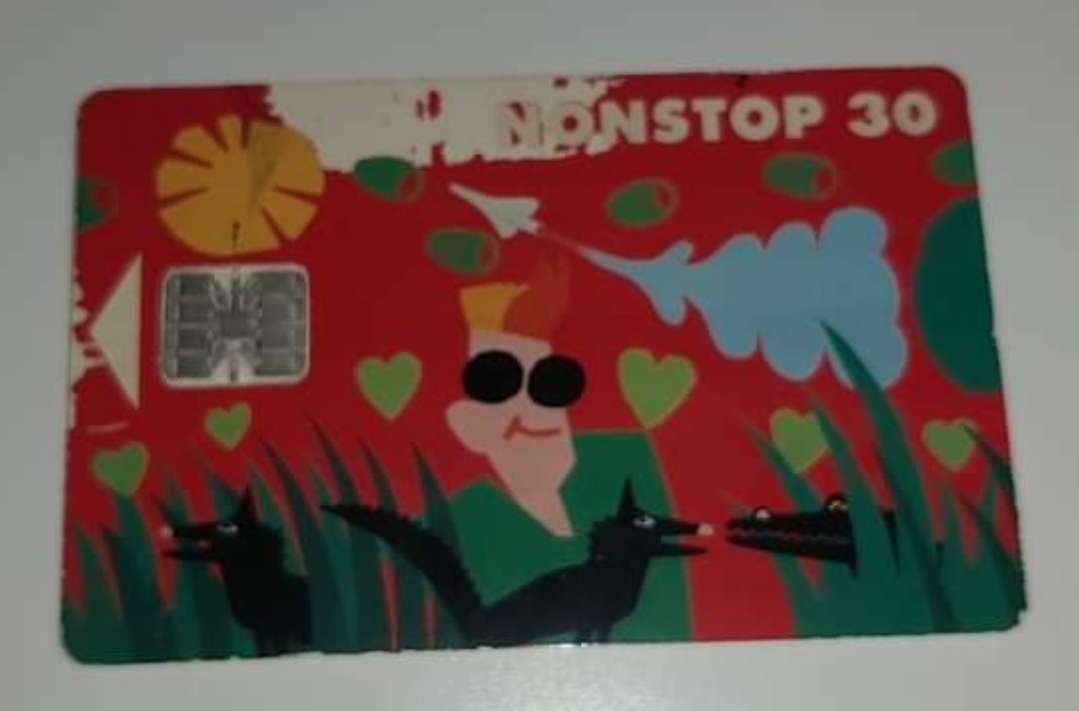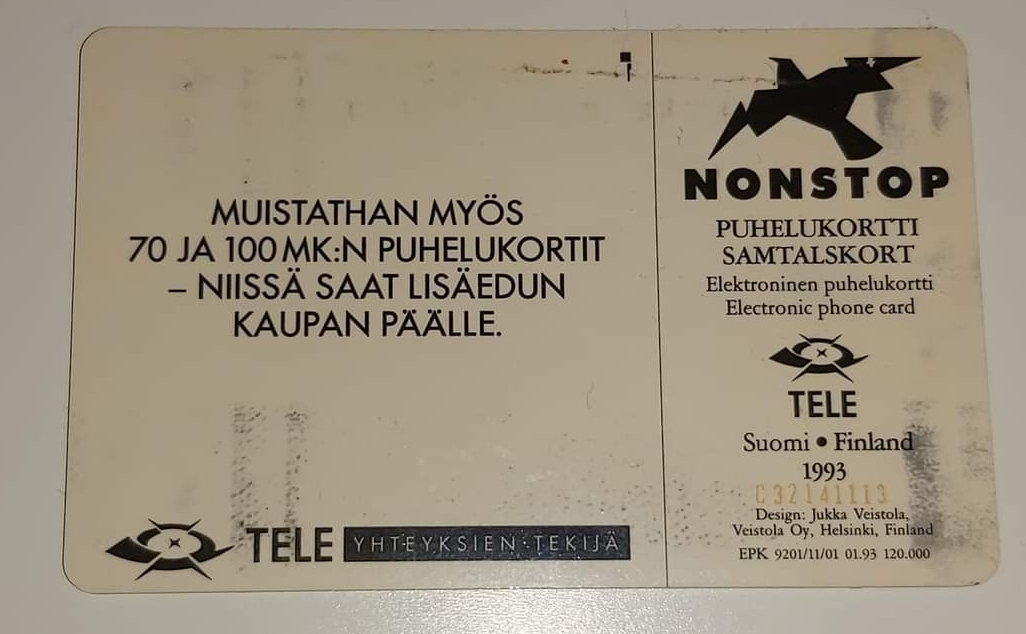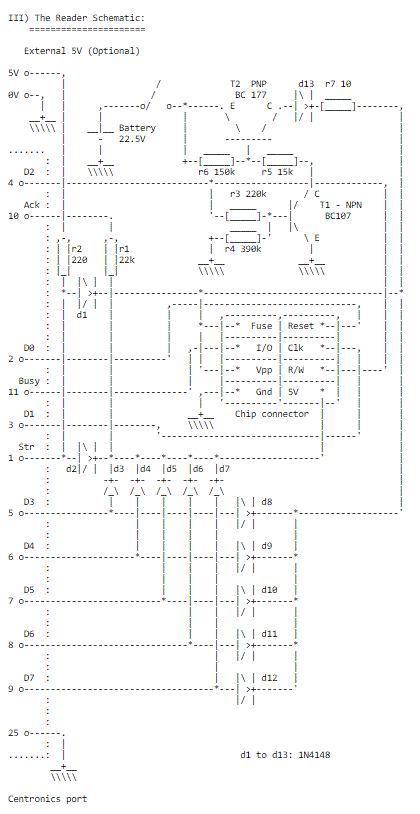Who remembers Phone booths and above all phone cards? Phone cards were a technological advance in the world of public telephone traffic in the 1990s. They allowed to make calls on many phone booths in Finland and phone cards were also a popular collector’s item, collected both used and unused: Telecom companies have placed advertising on phonecards, or featured celebrity portraits, artwork, or attractive photography. As the supply of any one design is limited, this has led some people to collect disposable phonecards.
The use of public telephones was common at the time and phone cards were seen as the cutting edge of development. Those were first launched on a large scale in 1986 in Germany by Deutsche Bundespost after three years of testing, and in France by France Télécom. Many other countries followed suit, including Ireland in 1990 and the UK circa 1994–1995. Tele (nowadays known with name Sonera) was the first to use phone card machines in Finland. Tele and several local telephone companies switched coin-operated telephones in telephone booths to card-operated telephone models in the early 1990s.
The cards had a certain amount of balance loaded at the time of purchase using chip technology. The first phase technology was technically quite simple and not very secure. But by the mid-to-late 1990s, highly secure technology aided the spread of chip phonecards worldwide.
The whole phone card technology was somewhat short-lived (especially in Finland) because in the late in the 1990′s they became unnecessary as cell phones became more common (thank’s to Nokia), which led to situation that the the previously common telephone booths disappeared from the street scene. Here are pictures of one 30 years old not so smart telephone booth calling cards used in Finland.
This type of telephone cards are the simplest type of “smart card”. The cards had a certain amount of balance loaded at the time of purchase, and this amount was stored to the card. Those telephone cards (as used in Finland and France) were technically simple memory card with smart card connector. This kind of memory cards only have some amount of memory inside the card and this memory can be normally read and written. There is normally nothing really intelligent inside those cards. There is a memory chip that has a small amount of card information it followed by memory are that contains the information of balance in the card.
A stored-value phone card stores the available balance in digital memory physically embedded in the card. This balance can be read by a public payphone when the card is inserted into the card reader. The stored-value system used in Finland write data to an embedded chip to reflect the new balance after a call. Used primarily for payphones, stored-value systems avoid the time lag and expense of communication with a central database, which would have been technically complex before the 1990s. In Finland the card had a memory area, where there was one memory bit for each token (30 mk card had 30 tokens) value in card. The tokens could be freely read, and one by one written to “used” state after use (but could not be turned back to not used state).
The technology worked, but it was not the most secure as a href=”https://en.wikipedia.org/wiki/Telephone_card”>the initial microchips were easy to hack. Some users found out that some cards could be hacked by scratching off the programming-voltage contact on the card, which rendered the phone unable to reduce the card’s value after a call. Also some people have built their own cards that looked like phone card to the phone, but they did not decrease the stored amount during use or were automatically reset back to card balance full state when removed from card. This kind of hack cards could be built at the time using a small thin circuit board and a small micro-controller soldered to it running a small program that emulates phone card operation.
I was interested in how those cards worked in the early 1990′s. I looked the technical information related to them and built my own hardware+software that allowed my PC to communicate with them.
Hacker magazine PHRACK issue 48 (September 1, 1996) published a two part article on electronic telephone cards technology. That article also mentions some of my work on the field (I improved some of the card communications software published in the article). The software enables you to dumb the memory of electronics phonecards to see the information in them. The software also allowed to write to cards (write out some bits to lower the balance).
You can find the article parts here:
Electronic Telephone Cards: How to make your own! (part 1)
Electronic Telephone Cards: How to make your own! (part 2)
Here are some picks from those articles:
{*****************************************************************************}
{ T E L E C A R D . PAS }
{*****************************************************************************}
{ This program enable you to dumb the memory of electronics phonecards }
{ from all over the world, so that you will be able to see which country }
{ the card is from how many units are left and so on …. }
{*****************************************************************************}
{ }
{ Written by Stephane BAUSSON (1993) }
{ }
{ Email: [email protected] }
{ }
{ Snail Mail Address: 4, Rue de Grand }
{ F-88630 CHERMISEY }
{ France }
{ }
{*****************************************************************************}
{* Thanks to: Tomi Engdahl ([email protected]) *}
{*****************************************************************************}
After the information was more widely on-line, more and more people figured out how to hack those phone card to get free calls. People hacked those card and sold fake cards in Finland to the point that phone companies had to start to try to catch the users of fake phone cards and magazines started to write about the problem.
Here is one article from 1996 on the phone card hacking problems in Finland:
Puhelinkorttien jäljitelmillä huijattu ilmaisia puheluita Tele joutui korjaamaan tuhansien yleisöpuhelimien suojausta
” Poliisi tutkii Suomessa ensi kertaa paljastuneita puhelinhuijauksia, joissa on puhelinkorttien jäljitelmien avulla huijattu ilmaista soittoaikaa. Simulaatiokorteiksi kutsuttujen jäljitelmien avulla huijari on voinut soittaa ilmaiseksi kuinka kauan tahansa.”
Just few years later the system started to shut down because in addition to free calls problems the increasing owning of of mobile phones started to make phone booths not as profitable anymore as it once was.
Sources:
https://en.wikipedia.org/wiki/Telephone_card
https://www.epanorama.net/links/smartcards.html#memorycard
https://www.turku.fi/blogit/kukkuu-kokoelmista/kokoelmanosto-kuvat-kortilla-yleisopuhelimien-lahihistoriaa
Electronic Telephone Cards: How to make your own! (part 1)
Electronic Telephone Cards: How to make your own! (part 2)
https://groups.google.com/g/sfnet.harrastus.elektroniikka/c/k2yqfJVb_aA/m/fqmm4nNa4MwJ
https://www.hs.fi/kotimaa/art-2000003536142.html
https://www.antikvariaatti.net/kerailyesineet/puhelinkortit



0 Comments
Be the first to post a comment.